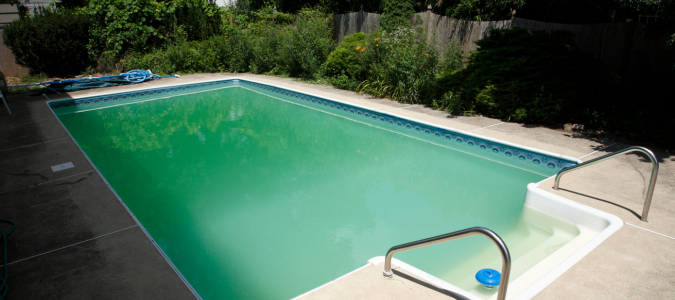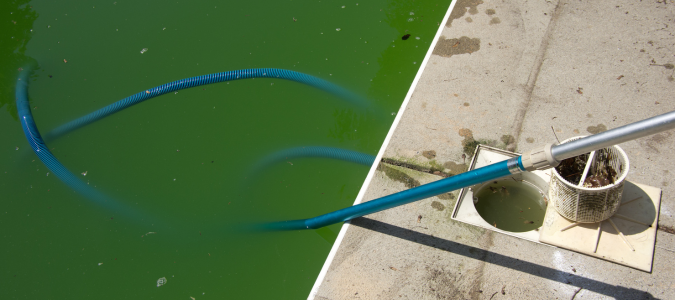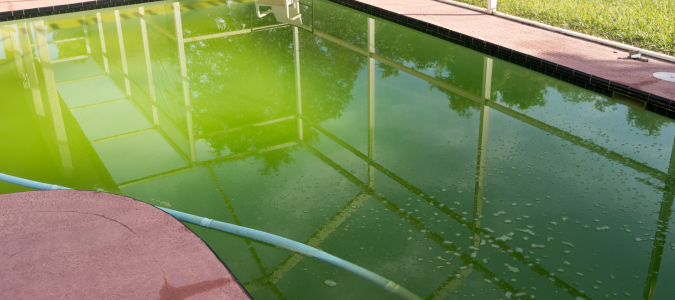Nothing is more refreshing than taking a dip on a blistering hot day. But the excitement can turn to frustration when you see that your swimming pool has turned green overnight. It can happen for various reasons, but algae are the most likely culprit. The best thing you can do is to shock the pool or use an algaecide. However, it can remain green even after these treatments. Let’s go through some possible reasons for this issue and what you can do to prevent it from happening again.
Why Pools Turn Green
It can be a puzzling experience when your pool turns green seemingly overnight, but it is likely due to a chemical imbalance. Here are some explanations behind the mysterious change in your pool’s color.
Algae Overgrowth
Algae is the most probable reason for your pool’s green hue. These organisms are usually kept in check by proper chemical balance, transitions to colder weather and water circulation. But if these things aren’t present, algae can spread quickly and make your pool green and murky. It’s normal to see algae in ponds and lakes, but it is usually more concentrated in pools and can be hazardous. It can indicate the presence of harmful bacteria, so don’t swim until the water is clear again.
Metals and Pollen
Pools come with metal parts, including ladders and pumps. Sometimes, these components can react with the chemicals in the pool, throwing off the chemical balance and causing the water to turn green. These metal components can also oxidize and contribute to the pool’s color change. Have a pool care specialist check these parts to ensure they are not deteriorating.
Pollen can also be to blame since their greenish-yellow tinge can color the pool. You can use a pool cover when you’re not using your pool to prevent this issue.
Low Free Chlorine Levels
Chlorine purifies water. When the chlorine level in your pool is too low, algae can take over and turn the water green. However, adding too much chlorine can also be harmful as it can cause the metal parts in your pool to oxidize. You shouldn’t be able to smell the chlorine in a well-balanced pool. Contact a professional if you’re struggling to achieve the correct chlorine level.
High pH
Pool water should neither be too acidic nor too alkaline. Ideally, it should be neutral with a pH of 7.3 to 7.6. If higher than that, the chlorine won’t be able to do its job, even if you add the right amount. That will allow algae to bloom. If the pool water’s pH is too high, it can be brought down with muriatic acid or sodium bisulfate.
The Pool Filter Isn’t Running Long Enough
It is the filter’s job to remove dirt, debris, pollen and algae from the water. But if your pool water is cloudy and green, that could mean the filter isn’t running long enough. It should run at least eight hours daily, possibly longer if many people use the pool. In addition, you must clean the filter regularly so it can keep working efficiently. DE filters need cleaning every one to three months, sand filters every one to four weeks and cartridge filters every two to six weeks.
High Phosphate Level
Algae feed on phosphate, so if there is a high phosphate level in the water, algae will thrive and take over your pool. The best solution to this problem is balancing the chlorine level.
Pools are fun, but they can be hard to maintain. Larger ones are more complicated because there is more water to filter. If you don’t know how to achieve the perfect chemical balance for your pool, contact a pool care specialist to help. The professional knows how to deal with green pool water and return your pool to its clean and clear state.
Is Your Pool Still Green After Shock and Algaecide?
Not all is lost if your pool is still green after shock and algaecide. Here are some possible reasons for it and what you can do to troubleshoot the issue.
Weak Shock Treatment
The shock you used may be expired or isn’t strong enough. It is also possible that you didn’t use it correctly. The ideal shock dosage is 1 pound per 10,000 gallons of water. But you may need to put more depending on the level of algae infestation. In severe cases, you might need to quadruple the amount of shock to get rid of algae in your pool. The key is to be patient. Sometimes, it can take multiple rounds of shocks to clear up the green pool water. Additionally, you must shock your pool at night because UV rays can break up the molecules in the treatment and render it useless.
Poor Water Circulation
Your pool must have excellent water circulation for the shock treatment to work. That way, the shock can reach every area and kill all traces of algae. A clogged pool filter can hamper water circulation and lessen the effectiveness of the shock treatment. If you see that yours is full of dirt and debris, wash it thoroughly or replace it. If it’s not performing efficiently, contact a pool care specialist to check it.
It’s Not an Algae Problem
Algae aren’t the only possible culprit behind a green pool. High copper content can also be to blame. If the water has a high copper level, the shock treatment can oxidize the copper and turn the pool green. That’s why it is essential to know where your water comes from. Well water is known to be heavy on copper, making it more susceptible to turning green from shock. High levels of tree, weed and grass pollen can also be causing the issue. It gives the water an unappealing greenish-yellow tint and requires a higher chlorine dosage.
Not Brushing or Vacuuming Thoroughly
If the water remains green after the shock treatment, it could mean that the walls are still dirty. There might also be an accumulation of pollen, algae and debris in the pool’s dead spots. These are the areas that water circulation can’t reach. You can address these issues with a pool cleaning regimen that includes brushing and vacuuming. That will help remove the pollutants in the water and keep the pool clean and clear.
Troubleshooting a green pool can be time-consuming. The best way to deal with the situation is to contact pool service experts. They will know how to restore the chemical balance in the water so you can swim comfortably again.
What Is Algaecide?
Algaecide is a product that prevents and kills algae. Some algaecides have copper ions as the active ingredient, while some use quaternary ammonium or polymeric quaternary ammonium compounds. Algaecides get rid of algae by disrupting their cellular processes. However, it is not an instant cure for an algae infestation. It works better as a form of prevention rather than a treatment.
To get the best results, choose an algaecide that suits the water in your pool. If the water has high metal levels, go for a copper-free algaecide. Adding more copper is a bad idea because it increases the chances of oxidation which can turn the water green. If you don’t know which algaecide is best and how to use it properly, leave the job to an expert. A pool care specialist will provide the best method for maintaining your pool.
When to Add Algaecide to Pool
If you don’t use chlorine in your pool to keep algae at bay, algaecide can be a sanitization alternative. Add it in weekly to keep the water from turning green. It is also good practice to add algaecide after every shock treatment. However, algaecide works best when you use it alongside a proper pool cleaning regimen. Pool care specialists can take care of the entire process.
They will determine the most suitable type of algaecide for your pool and how much to use. Pool experts can also balance the water’s pH and brush the pool tiles to increase the algaecide’s effectiveness. Once the pool is clean, they will switch on the pump and add the correct dosage of algaecide to the water. They will distribute it to different parts of the pool to remove all traces of algae. The last step is to vacuum the pool to remove the dead algae.
The Bottom Line
Is your pool still green after shock and algaecide? It can be hard to get the water back to its original clear state. There are many factors to consider, including the water’s pH level, how much metal it contains, and if there are other pollutants besides algae. Additionally, homeowners need tools like a brush and vacuum to address the issue.
If you can’t seem to get rid of your pool’s green hue, it is time to call pool care experts. They can pinpoint the root of the problem, whether it’s an algae infestation, metal oxidation or a high pH level. They have the tools, knowledge and experience to have your pool sparkling clean again.
ABC Can Keep Your Pool Clean
Contacting a professional pool cleaning and repair service is the best way to eliminate any type of algae in your pool and prevent it from coming back. You can try to get rid of it on your own, but it demands more time and effort than many homeowners have. ABC Home & Commercial Services pool professionals can handle pool cleaning and effectively remove algae. Save yourself time and hassle by contacting us when algae in your pool becomes a problem.



